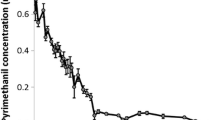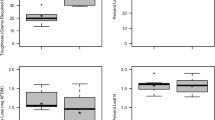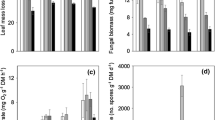Abstract
Inorganic fine sediments are easily carried into streams and rivers from disturbed land. These sediments can affect the stream biota, including detritivorous invertebrates (shredders) and impair ecosystem functions, such as leaf litter decomposition. We hypothesized that fine sediment (kaolin) deposited on leaves would reduce or suppress fungal development, reducing decomposition rates of leaves. Moreover, we predicted that shredders would act as ecosystem engineers by perturbing sediment deposition, reducing its impact on decomposition and fungi. We used a fully crossed experimental design of sediment addition (control, 400 mg L−1) and shredders (none, Gammarus, Potamophylax) in laboratory aquaria. Leaf mass loss, suspended solids, microbial respiration, fungal biomass and spore production were measured. Sediment addition had no significant effects on the leaf mass remaining nor on shredders’ consumption rates. However, sediment slightly reduced fungal assemblage richness and the sporulation rate of three fungal species. The presence of shredders substantially increased the resuspension of fine sediments (>300%), resulting in higher suspended loads. However, the action of shredders did not have a significant effect on fungal biomass nor on leaf mass loss. Even if shredders did not enhance fungal colonisation, they affected the settlement of fine sediment, serving as allogenic engineers. Our study suggests that concentrations of fine sediment of 400 mg L−1 with short exposure times (192 h) can have some effect on leaf decomposition.


Similar content being viewed by others
References
Allan JD, Castillo MM (2008) Stream ecology: structure and function of running waters, 2nd edn. Springer, Dordrecht
Bärlocher F, Kendrick B (1975) Leaf-conditioning by microorganisms. Oecologia 20(4):359–362
Benfield EF, Webster JR, Tank JL, Hutchens JJ (2001) Long-term patterns in leaf breakdown in streams in response to watershed logging. Int Rev Hydrobiol 86(4–5):467–474
Bermingham S, Maltby L, Cooke RC (1996) Effects of coal mine effluent on aquatic hyphomycetes. I. Field study. J Appl Ecol 33:1311–1321
Bilotta GS, Brazier RE (2008) Understanding the influence of suspended solids on water quality and aquatic biota. Water Res 42(12):2849–2861
Boubée JAT, Dean TL, West DW, Barrier RFG (1997) Avoidance of suspended sediment by the juvenile migratory stage of six New Zealand native fish species. N Z J Mar Freshw Res 31(1):61–69
Bunn SE (1988) Processing of leaf litter in two northern jarrah forest streams, Western Australia: II. The role of macroinvertebrates and the influence of soluble polyphenols and inorganic sediment. Hydrobiologia 162(3):211–223
Cardinale BJ, Gelmann ER, Palmer MA (2004) Net spinning caddisflies as stream ecosystem engineers: the influence of Hydropsyche on benthic substrate stability. Funct Ecol 18(3):381–387
Chauvet E (1987) Changes in the chemical composition of alder, poplar and willow leaves during decomposition in a river. Hydrobiologia 148(1):35–44
Chauvet E (1991) Aquatic hyphomycetes distribution in south-western France. J Biogeogr 18(6):699–706
Cordone AJ, Kelley DW (1961) The influences of inorganic sediment on the aquatic life of streams. In: California fish and game, vol 47, No. 2. California Department of Fish and Game, Inland Fisheries Branch, Sacramento, p 41
Cornut J, Elger A, Lambrigot D, Marmonier P, Chauvet E (2010) Early stages of leaf decomposition are mediated by aquatic fungi in the hyporheic zone of woodland streams. Freshw Biol 55(12):2541–2556
Costantini ML, Rossi L (2010) Species diversity and decomposition in laboratory aquatic systems: the role of species interactions. Freshw Biol 55(11):2281–2295
Cummins KW (1974) Structure and function of stream ecosystems. Bioscience 24(11):631–641
Dang CK, Gessner MO, Chauvet E (2007) Influence of conidial traits and leaf structure on attachment success of aquatic hyphomycetes on leaf litter. Mycologia 99(1):24–32
Davies-Colley RJ, Hickey CW, Quinn JM, Ryan PA (1992) Effects of clay discharges on streams. 1. Optical properties and epilithon. Hydrobiologia 248(3):215–234
Dodds WK, Whiles MR (2004) Quality and quantity of suspended particles in rivers: continent-scale patterns in the United States. Environ Manage 33(3):355–367
European Inland Fisheries Advisory Commission (1964) Water quality criteria for European freshwater fish. Report on finely divided solids and inland fisheries, vol EIFAC/1, Rome
Fisher SG, Likens GE (1973) Energy flow in Bear Brook, New Hampshire: an integrative approach to stream ecosystem metabolism. Ecol Monogr 43(4):421–439
Galbraith RV, MacIsaac EA, Macdonald JS, Farrell AP (2006) The effect of suspended sediment on fertilization success in sockeye (Oncorhynchus nerka) and coho (Oncorhynchus kisutch) salmon. Can J Fish Aquat Sci 63(11):2487–2494
Gayraud S, Herouin E, Philippe M (2002) The clogging of stream beds: a review of mechanisms and consequences on habitats and macroinvertebrate communities. Bull Fr Pech Piscic (365–366):339–355
Gessner MO, Chauvet E (1993) Ergosterol-to-biomass conversion factors for aquatic hyphomycetes. Appl Environ Microbiol 59(2):502–507
Gessner MO, Chauvet E (1994) Importance of stream microfungi in controlling breakdown rates of leaf litter. Ecology 75(6):1807–1817
Gessner MO, Chauvet E (2002) A case for using litter breakdown to assess functional stream integrity. Ecol Appl 12(2):498–510
Gessner MO, Bärlocher F, Chauvet E (2003) Qualitative and quantitative analyses of aquatic hyphomycetes in streams. In: Tsui CKM, Hyde KD, Ho WH (eds) Freshwater mycology: a practical approach. Fungal Diversity press, Hong Kong, pp 127–157
Goldes SA, Ferguson HW, Moccia R, Daoust PY (1988) Histological effects of the inert suspended clay kaolin on the gills of juvenile rainbow trout, Salmo gairdneri Richardson. J Fish Dis 11(1):23–33
Gotelli NJ, Colwell RK (2001) Quantifying biodiversity: procedures and pitfalls in the measurement and comparison of species richness. Ecol Lett 4(4):379–391
Graça MAS (2001) The role of invertebrates on leaf litter decomposition in streams—a review. Int Rev Hydrobiol 86(4–5):383–393
Herbst GN (1980) Effects of burial on food value and consumption of leaf detritus by aquatic invertebrates in a lowland forest stream. Oikos 35(3):411–424
Hieber M, Gessner MO (2002) Contribution of stream detrivores, fungi, and bacteria to leaf breakdown based on biomass estimates. Ecology 83(4):1026–1038
Holt CS, Waters TF (1967) Effect of light intensity on the drift of stream invertebrates. Ecology 48(2):225–234
Izagirre O, Serra A, Guasch H, Elosegi A (2009) Effects of sediment deposition on periphytic biomass, photosynthetic activity and algal community structure. Sci Total Environ 407(21):5694–5700
Jones CG, Lawton JH, Shachak M (1994) Organisms as ecosystem engineers. Oikos 69(3):373–386
Kiffney PM, Richardson JS, Bull JP (2003) Responses of periphyton and insects to experimental manipulation of riparian buffer width along forest streams. J Appl Ecol 40(6):1060–1076
Krauss G-J, Solé M, Krauss G, Schlosser D, Wesenberg D, Bärlocher F (2011) Fungi in freshwaters: ecology, physiology and biochemical potential. FEMS Microbiol Rev 35(4):620–651
Kreutzweiser DP, Capell SS, Good KP (2005) Effects of fine sediment inputs from a logging road on stream insect communities: a large-scale experimental approach in a Canadian headwater stream. Aquat Ecol 39(1):55–66
Laitung B, Chauvet E (2005) Vegetation diversity increases species richness of leaf-decaying fungal communities in woodland streams. Arch Hydrobiol 164(2):217–235
Larsen S, Ormerod SJ (2010) Low-level effects of inert sediments on temperate stream invertebrates. Freshw Biol 55(2):476–486
Lecerf A, Richardson JS (2010a) Assessing the functional importance of large-bodied invertebrates in experimental headwater streams. Oikos 120(6):950–960
Lecerf A, Richardson JS (2010b) Litter decomposition can detect effects of high and moderate levels of forest disturbance on stream condition. For Ecol Manage 259(12):2433–2443
Lecerf A, Dobson M, Dang CK, Chauvet E (2005) Riparian plant species loss alters trophic dynamics in detritus-based stream ecosystems. Oecologia 146(3):432–442
Liess M, Schulz R, Liess MHD, Rother B, Kreuzig R (1999) Determination of insecticide contamination in agricultural headwater streams. Water Res 33(1):239–247
Matthaei CD, Weller F, Kelly DW, Townsend CR (2006) Impacts of fine sediment addition to tussock, pasture, dairy and deer farming streams in New Zealand. Freshw Biol 51(11):2154–2172
Matthaei CD, Piggott JJ, Townsend CR (2010) Multiple stressors in agricultural streams: interactions among sediment addition, nutrient enrichment and water abstraction. J Appl Ecol 47(3):639–649
McKie B, Schindler M, Gessner M, Malmqvist B (2009) Placing biodiversity and ecosystem functioning in context: environmental perturbations and the effects of species richness in a stream field experiment. Oecologia 160(4):757–770
Moore JW (2006) Animal ecosystem engineers in streams. Bioscience 56(3):237–246
Navel S, Mermillod-Blondin F, Montuelle B, Chauvet E, Simon L, Piscart C, Marmonier P (2010) Interactions between fauna and sediment control the breakdown of plant matter in river sediments. Freshw Biol 55(4):753–766
Newcombe CP, Macdonald DD (1991) Effects of suspended sediments on aquatic ecosystems. North Am J Fish Manag 11(1):72–82
Nikolcheva LG, Bourque T, Bärlocher F (2005) Fungal diversity during initial stages of leaf decomposition in a stream. Mycol Res 109(2):246–253
Parkhill KL, Gulliver JS (2002) Effect of inorganic sediment on whole-stream productivity. Hydrobiologia 472(1–3):5–17
Petersen RC, Cummins KW (1974) Leaf processing in a woodland stream. Freshw Biol 4(4):343–368
Pringle CM, Blake GA, Covich AP, Buzby KM, Finley A (1993) Effects of omnivorous shrimp in a montane tropical stream: sediment removal, disturbance of sessile invertebrates and enhancement of understory algal biomass. Oecologia 93(1):1–11
Quinn J, Davies-Colley R, Hickey C, Vickers M, Ryan P (1992) Effects of clay discharges on streams. 2. Benthic invertebrates. Hydrobiologia 248(3):235–247
Relyea CD, Minshall GW, Danehy RJ (2000) Stream insects as bioindicators of fine sediment. In: Water Environment Federation® Technical Exhibition and Conference (WEFTEC®). Proceedings of the Water Environment Federation. Water Environment Federation, Watershed, pp 663–686
Sanpera-Calbet I, Lecerf A, Chauvet E (2009) Leaf diversity influences in-stream litter decomposition through effects on shredders. Freshw Biol 54(8):1671–1682
Schofield KA, Pringle CM, Meyer JL (2004) Effects of increased bedload on algal- and detrital-based stream food webs: Experimental manipulation of sediment and macroconsumers. Limnol Oceanogr 49(4):900–909
Shaw EA, Richardson JS (2001) Direct and indirect effects of sediment pulse duration on stream invertebrate assemblages and rainbow trout (Oncorhynchus mykiss) growth and survival. Can J Fish Aquat Sci 58(11):2213–2221
Sponseller RA, Benfield EF (2001) Influences of land use on leaf breakdown in southern Appalachian headwater streams: a multiple-scale analysis. J N Am Benthol Soc 20(1):44–59
Statzner B, Fièvet E, Champagne J-Y, Morel R, Herouin E (2000) Crayfish as geomorphic agents and ecosystem engineers: Biological behavior affects sand and gravel erosion in experimental streams. Limnol Oceanogr 45(5):1030–1040
Statzner B, Peltret O, Tomanova S (2003) Crayfish as geomorphic agents and ecosystem engineers: effect of a biomass gradient on baseflow and flood-induced transport of gravel and sand in experimental streams. Freshw Biol 48(1):147–163
Suren AM, Jowett IG (2001) Effects of deposited sediment on invertebrate drift: an experimental study. N Z J Mar Freshw Res 35(4):725–737
Tachet H, Bournand M, Richoux P, Usseglio-Polatera P (2000) Invertébrés d’eau douce: systématique, biologie écologie. CNRS Editions, Paris
Takao A, Negishi JN, Nunokawa M, Gomi T, Nakahara O (2006) Potential influences of a net-spinning caddisfly (Trichoptera : Stenopsyche marmorata) on stream substratum stability in heterogeneous field environments. J N Am Benthol Soc 25(3):545–555
Waters TF (1995) Sediment in streams: sources, biological effects and control. American Fisheries Society Monograph 7. Bethesda, Maryland
Wood PJ, Armitage PD (1997) Biological effects of fine sediment in the lotic environment. Environ Manage 21(2):203–217
Young RG, Matthaei CD, Townsend CR (2008) Organic matter breakdown and ecosystem metabolism: functional indicators for assessing river ecosystem health. J N Am Benthol Soc 27(3):605–625
Zhang YX, Richardson JS, Negishi JN (2004) Detritus processing, ecosystem engineering and benthic diversity: a test of predator-omnivore interference. J Anim Ecol 73(4):756–766
Acknowledgments
We are grateful to D. Lambrigot and S. Lamothe for their help with the field work and with the laboratory analyses, and to M.-H. O’Donoghue for her help with the bibliographic research. We are indebted to Mr. Dubillot who provided us the sediment. We thank E. Mas and three anonymous reviewers for comments on an earlier version of the manuscript. This study was made possible thanks to a grant from the University Paul Sabatier Toulouse 3 to JR as a sabbatical visitor, and funding for the InBioProcess project of the ANR Biodiversity programme (ANR-06-BDIV-007).
Author information
Authors and Affiliations
Corresponding author
Appendix
Appendix
See Table 1.
Rights and permissions
About this article
Cite this article
Sanpera-Calbet, I., Chauvet, E. & Richardson, J.S. Fine sediment on leaves: shredder removal of sediment does not enhance fungal colonisation. Aquat Sci 74, 527–538 (2012). https://doi.org/10.1007/s00027-011-0245-0
Received:
Accepted:
Published:
Issue Date:
DOI: https://doi.org/10.1007/s00027-011-0245-0




